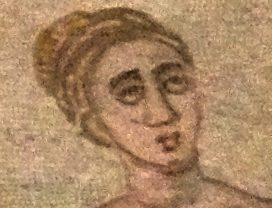1st quarter of the 4th century
Stone
Museo Pio Cristiano, The Vatican
The two scenes on the left present St. Peter's arrest in Rome and his water miracle, both episodes from apocryphal legend rather than scripture. As the story goes, while in prison he converted two of his jailers. To obtain water to baptize them he struck the rock wall of his cell with a rod. On the sarcophagus we see the miracle first and then the arrest. Both the jailer and the arresting officers are dressed in short tunics, trousers, and pannonian caps. Except for the trousers, that is how they are always dressed in images from this era. In both scenes, Peter holds a scroll to represent his teaching authority.
Left of the Peter scenes is one in which the dead are raised to life by Christ. Sommers identifies the small nude bodies as representing Ezekiel's vision of the dry bones restored to life by the Spirit of the Lord, here pictured as Christ (Ezekiel 37:1-14). The wand in Christ's hand is a conventional way of signifying his divine power.

Sommers suggests that the man addressing Jesus on the left may be Ezekiel, but I would argue that the artist has collapsed Ezekiel's vision with the Gospel story of the daughter of Jairus, the synagogue official who asked Christ to save his daughter in Matthew 9:18-19,23-25, Mark 5:22-24,35-42, and Luke 8:41-42,49-55. Ezekiel may be the one relegated to the background. The pallium on the man addressing Jesus bespeaks a position of authority, and the recumbent figure before them is almost certainly a young girl of about 12 years old, judging from her figure and the hair style, in which a horizontal band of hair separates the forehead from the rest of the coif. A contemporary mosaic of young women at play has several of them with their hair done this way.
In the center is the decedent. Her two-finger gesture indicates that she is addressing Jesus on her left. This gesture and the codex in her left hand suggest that she is communicating with him through prayerful reading of the scriptures. Meanwhile, he is curing the blind man, the small figure whose eyes he is touching with his fingers (Matthew 9:29, Matthew 20:34, Mark 8:23, and John 9).
The two scenes on the right present the multiplication of the loaves and fishes and Jesus' entry into Jerusalem. The iconography is mostly identical to other images in this era, with two exceptions. The loaves are not marked with crosses, and Jesus' ass is doubled by a foal that is walking alongside. Jesus' right foot rests on the foal. The addition of the foal reflects Matthew's comment, "Now all this was done that it might be fulfilled which was spoken by the prophet, saying: 'Tell ye the daughter of Sion: Behold thy king cometh to thee, meek, and sitting upon an ass, and a colt the foal of her that is used to the yoke'" (21:4).
View this image in full resolution.
Read more about St. Peter, the miracles of Jesus, Ezekiel, and the Entry into Jerusalem.
Both pictures photographed in situ by Richard Stracke, shared under Attribution-NonCommercial-ShareAlike license.
